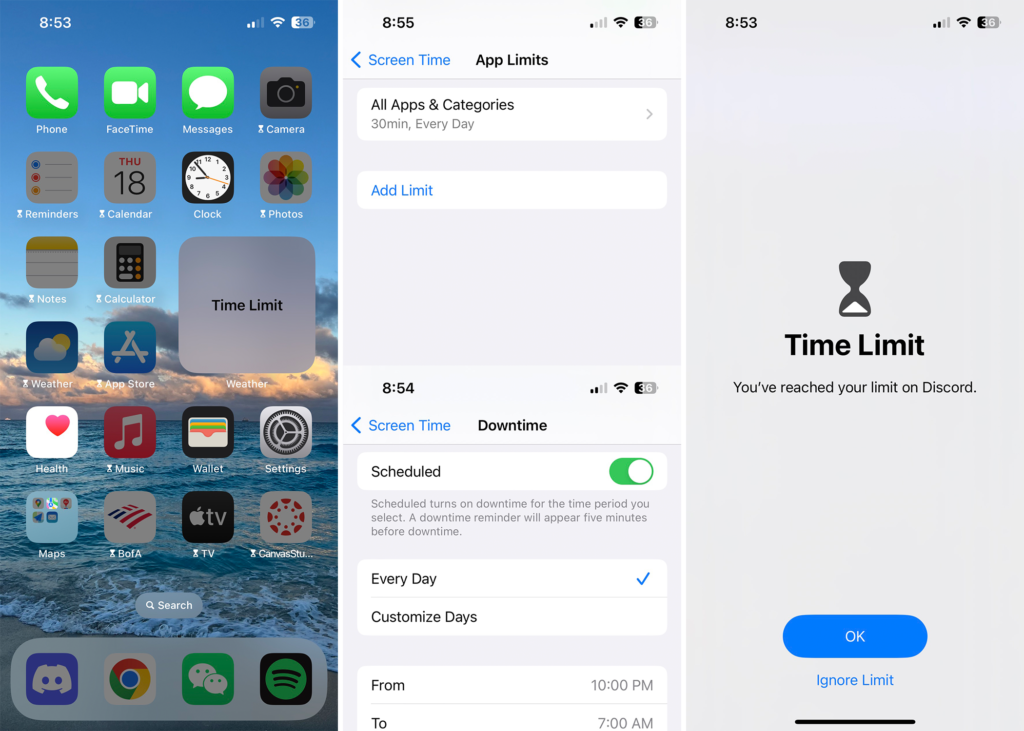During my middle school years, when the clock quietly struck 10 p.m., all the applications on my phone would gray out, locking me out until 7 a.m. the next day. No music, no social media, no websites — nothing could escape the grasp of my iPhone 6’s screen time control.
At the time, I thought unlimited access to my phone was my personal right. Not only was there downtime between 10 p.m. to 7 a.m., but my phone had a daily total of only 30 minutes of screen time, barely enough to watch a single YouTube video. After 30 minutes, I could only access necessary functions like making a phone call — not even texting — or taking a picture.
As I entered high school, my parents released their tight grip on my screen time, trusting that it was time for me to learn more self-control.
Despite how unfair I perceived this screen time limitation to be when I was younger, I now understand my parents’ decisions more. The self-control that screen time taught me has allowed me to greatly improve my mental and physical health and have more discipline than friends who struggle to shut off their phone when it’s time to study; according to Jai Medical Systems, reducing screen time can lead to a “healthy lifestyle by improving sleep habits, brain focus and physical posture.”
Since its inception, electronics have become extremely addictive to everyone, no matter the age. Many entertainment applications such as social media platforms or video games have been designed this way to attract the users to stay longer online. In fact, an article by Brill Mindz Technologies said that such apps are built “with the motive of offering different types of content to different individuals.”
When people are hooked to countless online activities and lose track of reality, they do not realize that their brain structures are also changing simultaneously. An article by the Specialty Clinic of Austin attributed this addiction to “brain chemical imbalances similar to what is seen with drug and alcohol dependency.” Research in the article also showed that technology addiction may be related to a change in the brain’s prefrontal lobe, which is responsible for “prioritizing life tasks.”
However, self-control for a teenager whose brain is still developing is especially challenging. The same even happens for many adults: In fact, the average screen time for American adults is 7 hours and 4 minutes per day, according to Jai Medical Systems.
All of this suggests a certain level of guardian interference is essential for children’s development.
A survey conducted by the Pew Research Center revealed that 86% of parents of a child aged 5 to 11 limit the time of day or length of time their child can use screens, while 80% say they take away their child’s smartphone or internet privileges as punishment.
Yet, on the other hand, parents and adults often see only evil in technologies: They may attribute electronic devices as the root cause of any failure for their child. But that explanation is too simple and ignores benefits such as improved problem solving and communication skills.
Even long after my parents have removed my screen time restrictions, I roughly maintain my same screen time. Though I still play video games and watch short videos, I know when to stop and when to play them as a rest in between intense work. All of this can be attributed to my parents’ decision to build up a healthy mindset and attitude with technology for me from a young age.
While limiting screen time has helped me form better habits and self-control, it may not be a method that works on all teenagers. When parents consider restricting their children, it is essential to find a compromise that both sides agree with. Electronics and screen time are not inherently evil inventions; instead, what matters is how they are being used. All children should be raised with a minimal screen time limitation that allows them to not only develop creative, social skills, but also a healthy lifestyle of self-control.




























